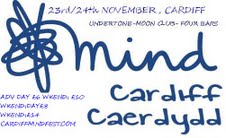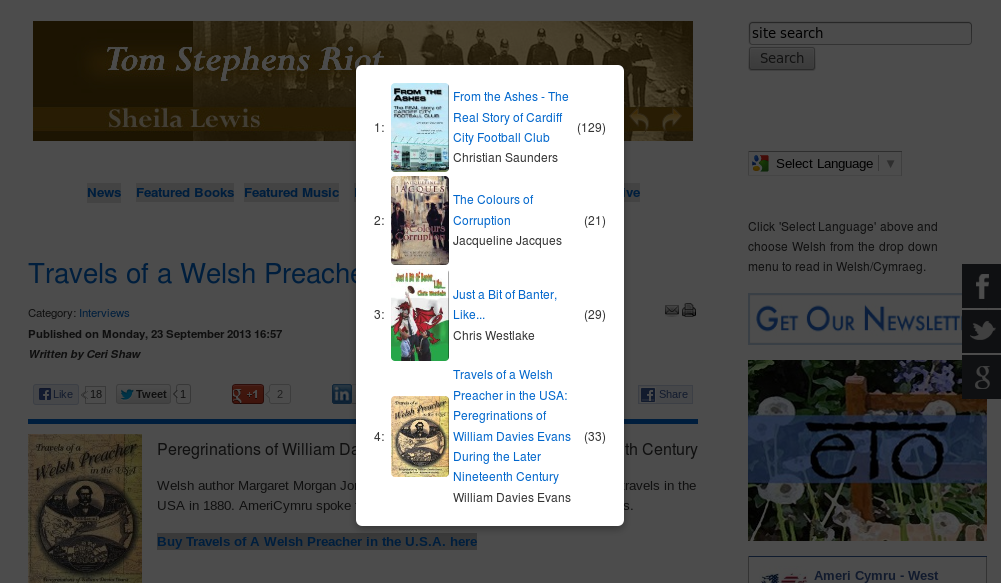Blogs
As many of our regular readers will know AmeriCymru has partnered with Celticos to help develop a new initiative for American tourists wishing to visit their ancestral homeland in north Wales. Janet and Don Folatjar of Pittsburgh, Pennsylvania are amongst the earliest visitors to take advantage of the Celticos/AmeriCymru Trail Tour.
We interviewed Janet before she left for her vacation ( read the interview here ) and we will be posting a follow up interview with her after her return this weekend.
As you can see from the image gallery further down the page, Janet got to meet a few celebrities in the course of her stay. She is pictured below with Scott Quinnell ( former Welsh international rugby league and rugby union player ) and Gareth Wyn Jones ( Welsh hill farmer extraordinaire and media personality ). You can listen to a recorded interview with Gareth Wyn Jones here .
In the course of her stay Janet's genealogical researches were ably abetted and refined by Keith Morris of Segontium Searchers. Keith's researches add a whole new dimension to the tour by enabling every visit to be uniquely adapted to the individual visitors requirements. Want to visit the place where your ancestors lived and worked? Take the AmeriCymru/Celticos Trail Tour!
Our recent interview with Keith Morris can be found here AND here is a link to the section on the S4C news program 'Heno' about the tour ( about 17 minutes in ).
READ MORE ABOUT THE AMERICYMRU TRAIL TOUR HERE
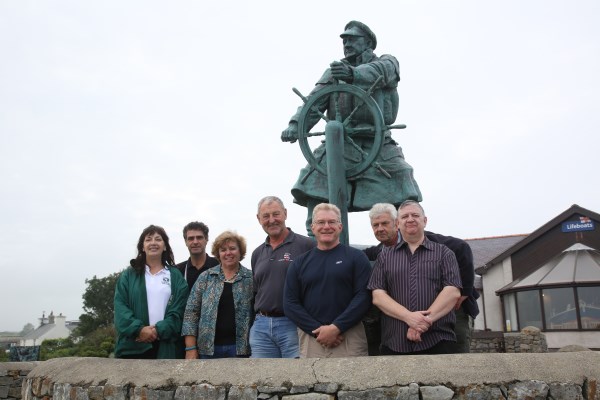 Excellent welcome from RNLI MOELFRE, Anglesey - the home of hero Dic Evans
Excellent welcome from RNLI MOELFRE, Anglesey - the home of hero Dic Evans
Janet & Don Folatjar meet Scott Quinnell and Gareth Wyn Jones on the AmeriCymru Trail Tour
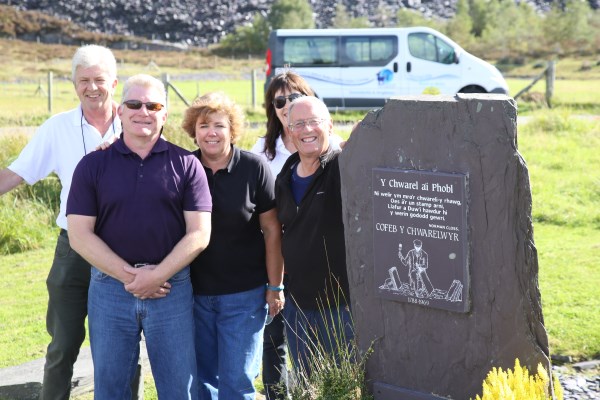 Cofeb y Chwarelwyr - Quarrymen's Memorial at Allt-Ddu
Cofeb y Chwarelwyr - Quarrymen's Memorial at Allt-Ddu
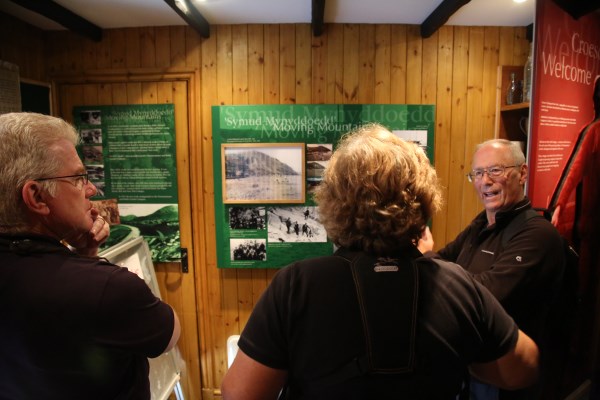 Welcome from Dave, New York Cottage Museum Penmaenmawr, Janets relatives worked in the quarry
Welcome from Dave, New York Cottage Museum Penmaenmawr, Janets relatives worked in the quarry
Prominent Welsh Jacobite, Sir Watkin Williams-Wynn (1692 – 26 September 1749) and Welsh involvement in the "The Jacobite rising of 1745",
Sir Watkin Williams-Wynn was a major land owner in North Wales, having inherited the estates of Llanforda near Oswestry, Wynnstay near Ruabon and those of the Wynn baronets of Gwydir, Caernarfonshire. He was MP for Denbighshire and mayor of both Oswestry and Chester. Wynn never concealed his Jacobitism, being the leader of the Cycle of the White Rose, the well-known Jacobite club in Wrexham and once publicly burning a picture of George I.
Wynn promised his assistance if there was a restoration attempt by the exiled Stuarts, but only if they were accompanied by a French army. So when the Young Pretender (Bonnie Prince Charlie) arrived in 1745, without an army, Wynn withheld his public support. He, therefore, avoided retribution after the defeat at Culloden.
Thomas Jones (26 September 1742 – 29 April 1803) - landscape painter, born in Trefonnen in Cefnllys, Radnorshire. His formative years were spent on his father's estate at Pencerrig near Builth Wells, hence, the name he is known by many is Thomas Jones Pencerrig. He was a pupil of Richard Wilson and is best known as a painter of Welsh and Italian landscapes in the style of Wilson. His painting "The Bard" has become an iconic image in Wales, recounting the legendary tale of Edward I’s massacre of the Welsh bards.
Olivia Newton-John, (born 26 September 1948) best remembered as co-star with John Travolta in the film adaptation of the Broadway musical Grease, which featured one of the most successful film soundtracks in Hollywood history.
Born in Cambridge, Olivia moved to Melbourne, Australia with her family when she was five, when her headmaster father, Brinley Newton-John who was born and raised in Cardiff and an MI5 officer during World War II, was offered a job at a college in New South Wales, Australia.
Cardiff MIND Fest is a weekend long festival featuring some amazing local and UK artists across three venues on 23rd/ 24th November 2013 .
Joining Fist of the First Man, Gwenno and Totem Terrors at Undertone on Saturday the 23 rd are excellent bilingual off beat pop of the Alex Dingley Band . Alex was formerly at the heart of the Texas Radio Band and released a single at the end of last year on Too Pure. R.Seiliog who presents psychedelic swells of kinder-tone synths while the night is fired up by Welsh anti-pop hero Y Pencadlys and Bristolian noise makers Repo Man .
Meanwhile on Sunday the 24 th on the God Is In The TV Zine stage The Moon Club a rocking bill which already includes Thee Faction, The Milk Race , and The Lash is further swelled by the addition of thrilling Cardiff-based noisepop five-piece Joanna Gruesome who released their terrific debut album Weird Sister via Fortuna POP! (Europe) this September, delightful female-fronted power pop act from Cardiff The Lovely Wars , who feature former members of The Pipettes and Victorian English Gentlemen's Club. While experimental Oxford act Salvation Bill and emerging local-psych-tykes Tarsiers are sure to warm up the stage. Proceedings for the afternoon are eased open by Bristol's Joyce The Librarian aka singer-songwriter Martin Callingham their sound is understated but undeniably beautiful, simple guitars and flashes of cello and trumpet back softly-spoken lyrics. 
Downstairs on the Making Minds Stage in The Full Moon upon a bill headed by Brighton's respected artist Chris T-T , Bristol's cult former Strangelove frontman Patrick Duff and Welsh Music Prize nominee Laurence Made Cry are joined by incendiary poetic polemicist and mental health worker Patrick Jones and Cardiff based Amerciana solo-artist Joshua Caole.
They are joined by Stephen Fry approved Nia a singer-songwriter now based in London but originally from North Wales with a hell of a voice and an ear for wonderful jazz/blues flecked storytelling song-writing. Pembrokeshires Nayfe SJ whose golden voice is at the heart of the work of Valleyers and Shiny Tiger aka Joel Dear who has been making rickety pop music since he was in sixth form. His shabby, shouty style has been compared to artists like Bright Eyes, Hefner, and Jonathan Richman. They are preceded by Cardiff's Francescas Word Salad a solitary show-woman who tells lamentful tales through macabre ballads coloured by brass, The Skunk-Boy Project aka Nate Swettenham a singer-songwriter from Leicester, is a solo artist playing ukulele and piano and 19 year old Chambles a precocious South Wales talent with a distinctive tone and 18th century influenced folk sound. The acoustic bill is completed by Swansea's fiery emerging talent Sarah Passmore , and local open mic stalwart and mental health activist Dai Sharkey.
More info on acts: http://www.cardiffmindfest.tumblr.com/artists
Three local promoters ( God Is In The TV Zine, Rockpie and Red Medicine ) have grouped together to organise a two day event, with the aim of promoting awareness of mental health issues within South Wales. Working with three mental health partner organisations ( Cardiff Mind, Journeys and Making Minds) in South Wales, raising funds for Cardiff Mind.
Final acts to be announced in a last wave, shortly. Including the Rockpie Promotions stage at Four Bars at Dempseys on Saturday the 23 rd of November.
ANNOUNCED LINE UPS:
SATURDAY THE 23RD OF NOVEMBER
Undertone (Red Medicine Stage)
Fist of the First man
Alex Dingley Band
Gwenno
Totem Terrors
R.Seliog
Y Pencadlys
Repo Man
SUNDAY THE 24TH OF NOVEMBER
The Moon (God Is in The TV Zine stage) Stage Time: 5pm- 11pm
Thee Faction
Joanna Gruesome
The Milk Race
The Lash
Tarsiers
The Lovely Wars
Salvation Bill
Joyce The Librarian
The Full Moon (Making Minds Stage) Stage Time: 3PM-10PM
Chris T-T
Patrick Duff
Laurence Made Me Cry
Joshua Caole
Patrick Jones(Poetry Set)
Nia Roberts
Nayfe SJ (Valleyers)
Shiny Tiger
Francesca Word Salad
Skunk Boy Project
Chambles
Sarah Passmore
Dai Sharkey
TICKET INFORMATION:
Advance:
Tickets Day 6
Weekend: 10
book at: http://www.wegottickets.com/f/6715
On the weekend:
Day tickets: 8
Weekend: 14
Discounts for those on benefits/NUS.
Contact:
LINKS:
http://www.cardiffmindfest.com
https://www.facebook.com/CardiffMindFest
PARTNERS:
http://makingmindsblog.wordpress.com/
http://www.journeysonline.org.uk/
PROMOTERS
http://www.godisinthetvzine.co.uk
https://www.facebook.com/pages/Red-Medicine-Promotions/447349191994485
https://www.facebook.com/RockpiePromo
VENUES:
http://www.thefullmooncardiff.com/
http://www.undertonecardiff.com/
http://www.facebook.com/Fourbarscardiff

Born this day 1969 in Swansea
Catherine Zeta-Jones
Catherine whose parents, Dai and Pat Jones, owned a sweet shop, showed an early interest in entertainment, starring in stage versions of "Bugsy Malone", "The Pajama Game" and "Annie". Then she had the lead role in "42nd Street" at age 15. She made her breakthrough on TV in The Darling Buds of May in 1991 and went on to appear in many films including Christopher Columbus; The Discovery, Catherine the Great, The Phantom, The Mask of Zorro, Entrapment, The Haunting and Traffic. In 2000, she married fellow film star Michael Douglas.
Today is the feast day of Saint Cadog (Cadoc) Born 497.
St. Cadoc is one of the most important early Welsh saints. He was a contemporary of Dewi Sant (St. David), St. Patrick of Ireland, St. Columba of lona and tutor of St Illtyd. It is said that he rivaled St David as Wales' patron saint.
Cadoc was the son of Gwynllyw, ruler of the Kingdom of Gwynllwg and Gwladys daughter of King Brychan of Brycheiniog. After the birth of his son, Gwynllyw went on a wild celebratory raid, but among the livestock that he stole, was the cow of an Irish monk, St. Tathyw of Caerwent. St Tathyw was not afraid of Gwynllyw and boldly went to confront him, demanding the return of the cow. Impressed by his bravery and faith, Gwynllyw would not let Tathyw leave with his cow until he baptized his newborn son into the Christian faith and to allow him to live under the monk's care. Cadoc was therefore sent to be educated at Tathyw's monastery in Caerwent.
When Cadoc reached adulthood, he declined to take charge of his father's army, preferring as he said, to fight for Christ. He subsequently made pilgrimages Jerusalem and Rome but was reportedly distressed that the Synod of Llanddewi Brefi was held during one of these absences.
Legend says that once whilst hiding in a wood from enemies, he surprised a wild boar. The animal charged him but disappeared before striking him. Cadoc understood this as a sign from God and the location became the site of the great church and monastery at Llancarfan, near Cowbridge. Legend also says he once saved his brother monks in a famine by tying a white thread to the foot of a mouse, that led them to an underground granary.
It is probable that in his later years he returned to the area around Abergavenny, where he was killed by Saxons in 570 whilst celebrating Mass.
Prime Minister of Australia (1915–1923) - Billy Hughes was born on this day 1862. During his long, stormy career he chopped and changed his political ties, representing four different parties being expelled by three, he was known as one of the fastest political wits in the history of the parliament.
William Morris Hughes (known affectionately as 'Billy') was born in London, the only child of Welsh parents. His father William Hughes was a carpenter at the House of Lords and a deacon of the Welsh Baptist Church in London. His mother Jane Morris, was a domestic servant, who died when Billy was seven, after which he moved to live with her family at Llandudno and attended the local grammar school.
Hughes migrated to Brisbane in 1884 and worked in a variety of jobs including rock breaker, railways tally clerk, blacksmith's striker, boundary rider, well sinker, farm labourer, ship's cook and swagman. He married Elizabeth Cutts in 1886 and the couple were to have seven children. To support the family, they started a business in Sydney, selling books and political tracts and Billy worked as an umbrella repairer.
In Sydney, Billy became interested in politics, joining the Socialist League and becoming a fiery street corner orator. He then became involved in workers unions before being elected to the New South Wales legislature in 1894. He was then elected to the first federal Parliament in 1901 and served as attorney general in three ministries before being elected as prime minister in 1915. This was during World War I and Billy developed into a popular and charismatic wartime leader.
In literary circles of the nineteenth century, Felicia Hemans was “one of Britain's most successful poets. Her most famous work is the poem entitled “Casabianca.” also known as, The Boy stood on the Burning Deck , which commemorates an actual incident that occurred in 1798 during the Battle of the Nile aboard the French ship "Orient" when Giocante, the young son of commander Louis de Casabianca remained at his post and perished even when the magazine he was guarding, exploded and burst into flame.
Felicia Hemans was born on September 25th, 1793 in Liverpool, but the family moved near to Abergele early in her childhood, which resulted in Felicia regarding herself as Welsh, referring to Wales later as "Land of my childhood, my home and my dead".
Felicia was regarded as a child prodigy, being fluent in French, Italian, Latin and German. She began to write poetry to help support the family after her father had abandoned them and published her first volume of poetry when she was only 14. By the time she was 25 she had married, had five sons and published six volumes of poetry. However just before the birth of her sixth son, she too was abandoned by her husband and in order to continue writing, she returned to live mother in North Wales. This proved to be a very productive period for Felicia, but after her mother's death in 1827, her work went into decline and it is also believed to have led to her own early death in 1835 at the age of 41.
Born on this day 1932 in Swansea
Terry Medwin - former wales soccer international, remembered for scoring the game-winning goal in the first round play-off which sent Wales to the quarterfinals of the 1958 FIFA World Cup. He played his club football for Swansea and Tottenham Hotspur, with whom he won the Double in 1961.
Born on this day 1949 in Neath
Leighton Phillips - former Wales soccer international, described as a 'granite' hard defender. During his career, he made over 450 appearances in the Football League for Cardiff City, Aston Villa, Swansea City, Charlton Athletic and Exeter City. He also won 58 caps for Wales.
William Frost, from Saundersfoot, arguably the true inventor of the flying machine, flew the "Frost Airship Glider" for the first and only time on 24 September 1896.
Frosts flying machine, described as a balloon powered hang glider, with helicopter-style blades operated by foot pedals, was witnessed to fly for 500 metres before crashing into bushes. However, as the event was not officially recorded and an overnight storm destroyed what remained of the craft, Frost died in 1935 without receiving the recognition his acheivement surely deserved.
Born on this day 1954 in Carmarthen.
Helen Lederer, comedy actresses, theatre actress, TV and radio presenter and comedy writer.
Starting her career at the Comedy Store in London, Lederer has since appeared in BBC's Naked Video and Absolutely Fabulous, as well as her stages roles in Educating Rita, Having a ball and The Vagina Monologues. She also writes regularly for magazines and national newspapers, such as Woman & Home, Mail on Sunday, The Telegraph and The Daily Express.
The Vale of Neath Railway line from Neath to Merthyr Tydfil was opened on 24 September 1851.
Further branches were opened from Gelli Tarw into the Dare and Amman valleys for goods traffic and included the Dare Viaduct (pictured), one of Isambard Kingdom Brunel's famous timber viaducts. It also operated the Swansea and Neath Railway which gave it access to the docks at Swansea and was amalgamated with the Great Western Railway in 1865.
Most of the Vale of Neath Railway and the Swansea and Neath Railway branch is still open today. The eastern portions of the line now serve as part of the Valley Lines network, with the western portion used for the distribution of coal from the Onllwyn and Aberpergwm collieries to Swansea Docks and to Aberthaw Power Station.
Rhys Henry Hughes (born 24 September 1966 in Cardiff)
Hughes is a prolific short story writer, with much of his work regarded as humorously eccentric. Interestingly, Hughes is one of the very few authors to have used OuLiPo in the English language, as a means of writing. OuLiPo being a is an international literary group using mathematical and logical techniques of writing.
Born on this day 1933 in Llywnhendy, near Llanelli
Terry Davies - former Wales and Lions rugby international, who was a notoriously strong and accurate tackler.
No I haven't developed a stutter. Just a quick note to let you know about the latest developments over on the Welsh American Bookstore site.
Mindful of the fact that it can sometimes be difficult to find individual titles amongst over 3000 catalogued items we thought we would add a 'Featured' feature to assist you. If you look at the graphics below you will easily see where it lives and how it works. It will display 4 or 5 of the latest featured titles and the product page will link to any relevant author interviews or reviews we have on the site.
All in all a handy feature for checking what's new or for occasional browsing if you're stuck for something to read and looking for new ideas. Enjoy 
Click here to visit the Welsh American Bookstore
NEW TITLE: Travels of a Welsh Preacher in the U.S.A.
Peregrinations of William Davies Evans During the Later Nineteenth Century
Welsh author Margaret Morgan Jones publishes her great-uncles account of his travels in the USA in 1880. AmeriCymru spoke to Margaret about the book and her future plans.
Buy Travels of A Welsh Preacher in the U.S.A. here
![]()
Book of the Day: 9/23/13 'Travels of a Welsh Preacher in the U.S.A.' Interview with author Margaret Jones
"I became involved with the project of translating Dros Gyfanfor a Chyfandir (Over Ocean and Continent) by Reverend W.D. Evans (my gr eat-uncle) after the authors direct descendants had traced me down on their visits from the U.S.A. to Wales. Because the book was written in Welsh, Evans descendants had no idea what the book contained. On one visit, they put me on the spot and asked me to translate this page and that page, so I told them that I would translate the whole book for them."
Augustus - the founder of the Roman Empire and its first Emperor was born on this day 63 BC.
Roman interaction with Celtic Wales, during the life and reign of Augustus;
Roman interest in Celtic Britain during the lifetime of Augustus (23 September 63 BC – 19 August 14 AD), culminated in Claudius's successful invasion of 43 AD and the subsequent occupation of Wales. Prior to Roman interest in conquering Britain, Wales, had, at least five tribal groupings: the Deceangli in the North East; the Ordovices in the North West; the Demetians in the South West; the Silurians in the South East; and the Cornovii in the central borderlands. Its people, like those of most of Britain, spoke Brythonic, the language which would eventually evolve into Welsh. They were highly skilled in many crafts and traded across Northern Europe.
58 BC - General Julius Caesar, who was fighting to secure Gaul for Rome calculated that conquering Britain and Gaul would be a tremendous boost to his career. Hearing of Caesars' planned invasion from traders in the northern Gallic ports, resulted in some of the British tribes sending embassies to Caesar, offering friendship and hostages as surety. This shows that the Britons, could not simply have been introspective farming communities as they were capable of gathering intelligence from foreign shores and then undertaking a proper diplomatic mission in response.
55 BC - The first invasion of Britain under Julius Caesar was probably an investigative probe in preparation for the much larger invasion of the following year. Although he gained a beachhead on the coast, he could not advance further, and returned to Gaul for the winter.
56 BC - Julius Caeser returned, better prepared and with a larger force, and advanced inland, and established a few alliances. However, poor harvests in Gaul led to widespread revolt, which forced Caesar to leave Britain. From his reports, there is little evidence to suggest that the tribes of Wales were affected at all.
27 BC - The reign of Augustus begins. It was an era of relative peace known as the Pax Romana, however, Augustus did dramatically enlarge the Empire and had also prepared invasions of Britain in 34 BC, 27 BC and 25 BC, which were called off due to incursions elsewhere or peace settlements.
14 AD - Augustus died
40 AD - King Cunobelinus of the Catevellauni, who enjoyed friendly relations with the Roman Empire, died with his sons Caratacus and Togodumnus taking over control. His third son Arminius aggrieved at being passed over for power, appealed to Rome for assistance and persuaded Caligula to invade, however, its execution was bizarre: he reached Boulogne and drew up his troops in battle formation facing the English Channel and ordered them to attack the standing water. Afterwards, he had them gather seashells, to return to Rome with, as plunder.
43 AD - Emperor Claudius, sent 40,000 troops, under the command of Aulus Plautius to invade Britain. British resistance was led by Togodumnus and Caratacus but they were defeated on the rivers Medway and Thames. Togodumnus died shortly after the battle and Caratacus retreated west to the tribes of the Ordovices and the Silures, where he led the resistance to Rome.
The Celtic festival of Mabon - The autumnal equinox
The autumnal equinox is the time when the day and night are of equal length. This solar event was of great importance to the Celts who used the sky as both clock and calendar and as such, was seen as a turning point when it was time to give thanks for the fruits of the earth and get prepared for the colder months to follow.
The "Harvest Moon" and "Hunter's Moon are also associated with the autumnal equinox. The "Harvest Moon" is the full moon closest to the equinox and the "Hunter's Moon" is the one following it.
The Celts do not seem to have had a specific name for this time of year, but it has become widely known recently as Mabon, named after the character from the mabinogian, Mabon ap Modron.
Mabon Ap Modron was stolen from his mother when he was only 3 days old and kept hidden for many years. His rescue becomes the task for King Arthur’s adopted brother, Cei and Gwrhyr, a translator of animal languages. They seek out a Blackbird, a Stag, an Owl and an Eagle, each older and wiser than the previous until they encounter the enormous salmon of Llyn Llyw, who carries them to Mabon's prison in Gloucester. King Arthur then mounts an attack, allowing Cei to enter the rear of the prison and rescue Mabon.
John Paul Jones - "The father of the US Navy"
A battle between "Bon Homme Richard" of the Continental Navy of the American Revolution and the British "HMS Serapis", was fought on September 23rd, 1779. It was a bitter engagement of The American Revolutionary War, which cost the lives of nearly half the American and British crews.
The captain of the "Bon Homme Richard" was John Paul Jones, a Scotsman of Welsh descent and when the Bonhomme Richard began taking on water and fires broke out on board, British victory seemed inevitable. However when asked by the British commander if he wanted to surrender, Jones gave his now famous reply, "I have not yet begun to fight!" True to his word, Jones went on to win the day and is remembered for his refusal to surrender even when faced with what appeared to be an impossible situation.
John Paul Jones was born in a humble gardener's cottage in Kirkbean, Kirkcudbrightshire, Scotland and went to sea as a youth. He settled in Virginia and volunteered to fight for the navy of his adopted country in the War of Independence. He is regarded by many as "The father of the US Navy" as it was he who raised the Continental ensign on board the flagship of the Navy's first fleet.
He later took the war to Britain, where he was considered a pirate, with daring raids along the British coast. He was active in the waters around Tenby, where one of his officers by the name of Leekie Porridge came from. There is a beach named Jones on Caldey Island and his ghost is said to haunt the island.
"Turner and the Masters" an exhibition of "Landscapes of Wales" by J.M.W. Turner, one of England's greatest artists and the paintings that inspired him, went on show together for the first time at Tate Britain, London, from 23 September 2009.
J.M.W.Turner was "particularly devoted to the Welsh landscape because of its dramatic mountains and the stunning scenery and made five visits to Wales during 1790s. He also very much admired the Welsh painter Richard Wilson and on one of his Welsh visits made a pilgrimage to Wilson's Monmouthshire birthplace and made Wilson-like art copies.
Born on this day 1951 in Pontywaun, Cross Keys,
Jeff Squire - former Wales rugby captain and Lions international
On this day in 1749, Howell Harris found "Madam Griffith" awaiting him at Treveca, his home near Talgarth, with the news that her husband had beaten her and thrown her out of the house for refusing to give him any more money. This was to be the beginning of a relationship that would cause considerable controversy.
Harris who is regarded as the founder of the Presbyterian Church of Wales (also known as the Calvinistic Methodist Church) was born at Talgarth in 1714. He underwent a religious conversion while listening to the Rev. Pryce Davies in the local church in 1735. He immediately began to evangelise and hold meetings, encouraging others to seek the same assurance that he had of Christ's forgiveness. He was refused ordination in the Church of England because of his "Methodist" views, so became a preacher travelling throughout Wales, even though his preaching often put him in great personal danger.
In 1750, following the public scandal of his relationship with "Madam Griffith", he retreated from public life and founded a religious community called Teulu Trefeca. However, Harris returned to preaching in 1763 and died in 1773. He is buried at Talgarth and it is said that twenty thousand people attended his funeral.
In the early 18th century, Wales was the centre of an educational movement that was taking the world - by storm.
On 22nd September 1731, Griffith Jones (Llanddowror) wrote to the Society for the Promotion of Christian Knowledge (SPCK) proposing that a Welsh school be set up at Llanddowror. This marks the beginning of the circulating schools movement.
Griffith Jones (1684 – 8 April 1761) was a minister of the Church of England and while a curate at Laugharne he became a teacher at the school there and when made rector of Llanddowror, became concerned about the illiteracy of his parishioners. He wanted people to read so that they could read the Bible, so in 1731, he came up with the idea of Circulating Schools, which were held in one location for about three months before moving to another. Schools were run in barns and storehouses and, in one case, a windmill. The language of instruction was Welsh, the language of the people and the teaching was done mainly through religious texts.
The idea was met with enthusiasm and he received significant support from Madam Bevan, a local landowner, who continued to run the schools after Jones's death in 1761. It is estimated that the system educated over 200,000 in 3,500 schools throughout Wales. The system also received interest from other parts of Britain and also from Russia, where Catherine II commissioned a report on the activities of the schools in 1764, with a view to creating a similar system in her own country
It is strongly argued that Jones helped to make Wales into a more literate and literary nation.
The Gresford Disaster occurred on 22nd September 1934 at the Gresford Colliery, near Wrexham.
This remains one of Britain's worst ever coal mining disasters, which resulted in the death of 266 men and boys when a massive explosion ripped through the mine. There were only 6 survivors and only 11 of the victim's bodies were ever recovered.
The cause of the disaster was never proven, but the inquiry suggested many contributory factors, which included poor mine management and safety procedures.
The London-based Welsh Society 'Y Cymmrodorion' was established on 22nd September 1751. The name is taken from the Welsh: cyn-frodorion, meaning earliest natives.
The Society was founded by the Morris brothers (Lewis and Richard) from Anglesey, mainly as a philanthropic, social group to promote Welsh culture and literature within the Welsh community living London, however, its membership is open to all, with currently, two-thirds of its members coming from Wales.
Ruth Jones (born 22 September 1966 in Bridgend) is an actress and writer, who co-starred in and co-wrote the award-winning TV comedy series, Gavin & Stacey. She also starred as Hattie Jacques in TV movie Hattie and as Stella in the TV series Stella. In 2008, she and her husband David Peet co-founded the TV production company Tidy Productions.
Dirty Sanchez: The Movie, a reality film based upon the original TV series, was released on 22 September 2006. It features Welshmen, Matthew Pritchard, Michael Locke and Lee Dainton, with Londoner Dan Joyce.
The film features stunts even more extreme than those shown on their TV show and also contains a battle between Dirty Sanchez and the Japanese team, the Tokyo Shock Boys, in which the Dirty Sanchez boys are victorious.
On 21st September, 2002 stonemason Ray Collins commenced work on a commemorative garden in recognition of the Australian emigrants who arrived on the First Fleet at Botany Bay in 1788.
Of the emigrants who were actually convicts, six were Welsh, four men and two women and by 1852, the number of transportees who had been tried in Wales had risen to approximately 1,800, of whom, 300 were women. These included Lewis Lewis for his part in the Merthyr Riots of 1831 and the Chartist leaders John Frost, Zephaniah Williams and William Jones for their organising of the Newport Rising of 1839.
In September 1938, flooding caused the Dolaucothi Gold Mine in Carmarthenshire to finally close.
It is thought that the mine at Dolaucothi was first opened in the late Bronze age, perhaps as early as 600 BC. However, serious excavation commenced in approximately 75 AD, during the Roman rule of Britain. The Romans used slaves for the hard manual labour of extracting the gold deposits, which were destined for the Imperial Mint in Lyon.
Following the Romans' departure from Britain, it wasn't until the 17th or 18th centuries that mining recommenced at the site on a small scale but it was in the 19th that there was expansion beyond the original open cast. A large amount of ore was extracted during the 1930s, but after 1938 the mine was no longer used for commercial enterprise and it is now owned by the National Trust.
On 21st September 1987, there was a reported sighting of the Afanc of Llyn Llangors (Llangorse Lake)
The Afanc is a lake monster from the mythology of Wales, described as taking the form of a giant beaver or large crocodile, which devoured anyone or anything that entered its waters.
The earliest known literary reference to the Afanc is in a poem by the 15th century Welsh poet, Lewys Glyn Cothi. One legend tells of the wild thrashings of the afanc causing flooding and another tells of a maiden taming the Afanc and letting it sleep in her lap, whilst other villagers attempt to capture it. However, the Afanc awakes and crushes the maiden. Later legends have King Arthur slaying the Afanc in Llyn Barfog in Gwynedd. Nearby is a rock with a hoof print mark in it, which was supposedly made when Arthur's horse, Llamrai, dragged the Afanc from the lake. Iolo Morgannwg then popularised a version in which two long-horned oxen dragged the Afanc from the lake, to be killed.
On 21st September 1949, the Prince Llewelyn Hotel in Beddgelert, Gwynedd was hit by a meteorite. It is only the second ever known to hit Wales, the other falling in 1931, at Pontllyfni, near Caernarfon.
The meteorite was preceded by a brilliant light and a series of dull explosions, which ended with a buzzing sound and the sound of roof slates shattering. The following morning a dark-coloured stone the size of a cricket ball was found on the floor of the attic.
The first comprehensive school in England and Wales opened on 21st September 1949 as Holyhead County School.
Born on this day 1956 in Cardiff
David Giles - Former Wales soccer international.
On 20th September 1891, Buffalo Bill Coady and his Wild West Show performed at Cardiff, which was to be the first of many further visits to Wales.
William Cody was riding for the Pony Express when aged 14 and 3 years later, he was serving for the union during the American Civil War. After the war, he worked as a buffalo hunter for the Kansas Pacific railroad, for whom he is said to have shot in excess of 4,000 buffaloes and this is how he got the name Buffalo Bill.
Bill came to international attention when a report was published about him when he guided the Grand Duke Alexis of Russia on a tour of the wild, which was followed by a series of novels about his adventures as Buffalo Bill, King Of The Border Men. Then in 1883 Bill set up his famous Wild West show, which in 1887 was invited to Britain as part of the celebrations of the Golden Jubilee of Queen Victoria. His party comprised of 500 people including cowboys and Indians, as well as backstage workers and grooms. It also had 180 horses and 18 buffalo as well as elks and Texas longhorn cattle. One of the group was the famous Annie Oakley, who for one for one her tricks, shot a cigar from the mouth of the German Kaiser William I, the grandson of Queen Victoria.
The visit was a great success and he returned in 1891, to tour many cities, including Cardiff, where he performed at Sophia Gardens for three nights, with each show attracting over 20,000 people. Bill returned again in 1902, this time performing in many more venues, on a tour that lasted until 1904 The welsh towns that hosted on this tour were; Aberdare, Aberystwyth, Bangor, Barry Dock, Bridgend, Builth Wells, Cardiff, Carmarthen, Caernarfon, Dolgellau, Ebbw Vale, Holyhead, Llandudno, Llanelli, Neath, Oswestry, Pembroke Dock, Porthmadog, Rhyl, Ruabon, and Swansea .
On 20th September 1950, the rationing of soap ended in Wales and the rest of Britain, with the rationing of other essential commodities, such as butter and sugar continuing until 1954.
During World War II, the fact that rationing was affecting everyone created a sense of shared sacrifice, however, bread, potatoes, cigarettes and beer, were never rationed, due to the effect that might have on public moral.
The Dowlais Ironworks in Merthyr was founded on 20th September 1750. It was to become recognised as a centre of innovation in the industry and at one time, was the largest steel producer in the UK. It became part of British Steel in 1967, finally closing in 1987.
The works owed much of its initial success to a contract for iron rail for the rapidly expanding railroads and in 1845, it was employing 7,300 people in its 18 furnaces, that were producing 89,000 tonnes of iron per annum. It was also the first place to use the innovative Bessemer Process for mass production of steel and by 1857 owned the most powerful rolling mill in the world.
Actress, Rachel Roberts was born 20th September 1927 in Llanelli.
Initially a stage actress, Roberts made her film debut in 1954 in "The Weak and the Wicked". She is perhaps best remembered for her role as the love interest of Richard Harris in "This Sporting Life" for which she was nominated for an Oscar award, but also performed memorably in films including "Murder on the Orient Express", "When a Stranger Calls" and "Charlie Chan and the Curse of the Dragon Queen".
She was married and divorced twice, the second time to Rex Harrison, with the breakup of the relationship leading to her suffering with alcoholism and depression and eventually to her committing suicide on 26th November 1980.
Born on this day 1974 in Suva, Fiji and brought up in Abergavenny
Owen Sheers - poet, author, playwright, actor and TV presenter. His appointment as writer in residence at the Welsh Rugby Union was the first appointment in that role by any national rugby union team.
Prince Arthur, born on September 20th, 1486, was the eldest son of Henry VII and Elizabeth of York.
Arthur was so named due to Henry VII’s fascination with the legend of King Arthur and his birth at Winchester was significant as it was seen as the spiritual home of King Arthur’s Round Table.
1490 - Arthur was created Prince of Wales.
1501 (November 14th) - Arthur's marriage to Catherine of Aragon was seen as advantageous to both Britain and Spain to the threat posed by France. They set up their household at Ludlow Castle.
1502 (April 2nd) - Arthur fell ill and died and this death led to Henry, his younger brother, becoming the heir to the throne, who as Henry VIII went on to marry Catherine. Later, during their divorce, Henry's claim that Catherine was not a virgin when she married him, was pivotal to their subsequent divorce, in spite of Catherine's insistence to the contrary.
Sir Thomas Salisbury, heir to the Lleweni estate. was one of the conspirators executed by being hanged, drawn and quartered on 20th September 1586, for his involvement in the Babington Plot to murder Queen Elizabeth I and replace her with Mary, Queen of Scots.

